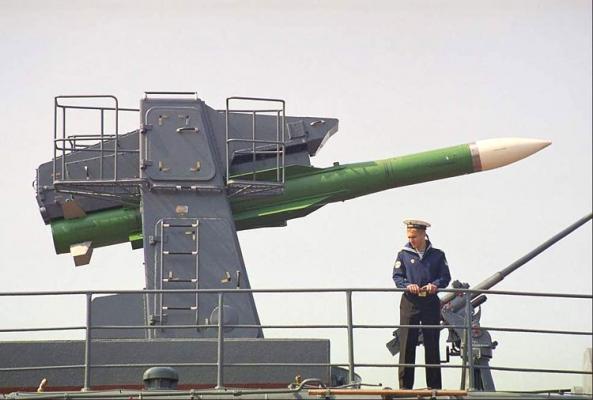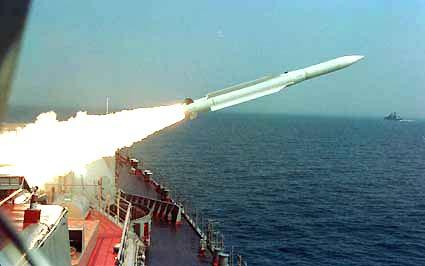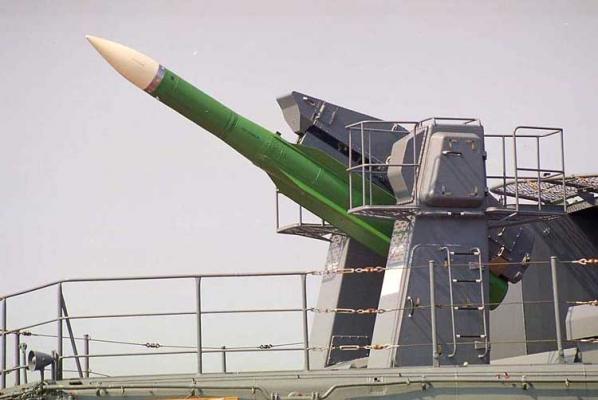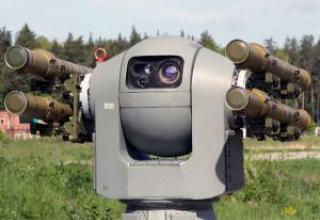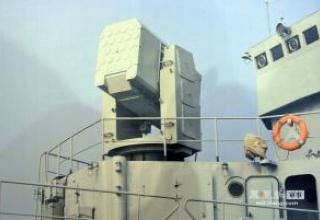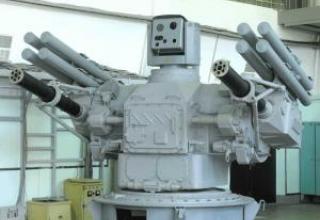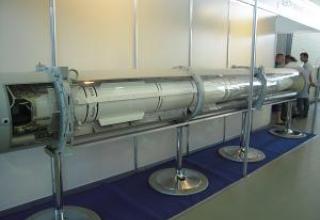The M-22 "Hurricane" ship multipurpose medium range missile system is designed for air defense of ships by covering protected ships and individual protection of the carrier ship from simultaneous attackers from different directions of anti-ship missiles and aircraft.
The development of an anti-aircraft missile system M-22 "Hurricane" for the Soviet Navy was initiated by the Decree of the CPSU Central Committee and the USSR CM dated January 13, 1972 in the NGO "Altair" (Chief Designer Volgin G.N.). This Resolution also set the development of military SAM 9K37 "Buk". Hurricane" and "Buk" complexes were unified by anti-aircraft guided missile.
In 1983, the M-22 SAM system was adopted for service with the 9M38 SAM system.
The complex was installed on Soviet "Sovremenniy" type destroyer squadrons (project 956). From 1985 to the present time, 16 ships of this class were built, and after 2000, 2 destroyers for the Chinese Navy.
Two MC-196 M-22 SAM systems are located respectively in the bow and stern of the ship directly behind the AK-130-MR184 artillery pieces. Ammunition for missiles is 48 pieces.
The ship's Hurricane SAM system is offered for export under the name "Stil".
Further development of this complex was the "Hedge" SAM system unified with the army Buk-M2 SAM system according to 9M317.
Composition:
The ship's Hurricane anti-aircraft missile system does not have its own target detection radar, as, according to the designers, the creation of a detection system duplicating the main ship's general station will lead to unreasonably high labor costs and weight-size characteristics of the complex. Therefore, the Hurricane receives information from the three-axis ship-wide detection and target designation radar, which has reduced the reaction time (from detection to missile descent) to 6 seconds.
The ZR-90 ship control system is operated by the general detection radar MR-700 (Fregat-M) installed on the main mast. The coordinates of all detected targets are received at the central post by the OI-5C (airborne information multiplier). Radar spotlights (OP-3) (see photo), two target extrapolators (OP-14), a target distribution device (ОК-10ВП), televisions (ОТ-10), a fire control device (ОК-10) and others are a rather complicated chain of primary radar information transmission to the missile itself. Theoretically, the control station is capable of escorting 24 targets and firing 19 (if the ship has a corresponding number of tele-optical visions and spotlights), but in practice these figures are 12 and 6 targets respectively.
The control system of the complex includes information display and firing control devices, a digital computing complex, a target illumination system and a system of tele-optical visions. The radio projectors of the illumination system are placed on the ship's superstructures in such a way that they can be used simultaneously in any direction.
The anti-aircraft missile 9M38/9M38M1 is made with the use of a dual-mode solid fuel engine (total operating time - about 15 seconds), according to the normal aerodynamic scheme with the "X" wings of small elongation. In the front part of the rocket are sequentially placed semi-active homing head, autopilot equipment, power supplies and combat unit. To reduce the spread of alignment over the flight time, the combustion chamber of the RDTT is placed closer to the middle of the missile and the nozzle block includes an elongated gas stroke, around which there are elements of the steering drive. The rocket has no detachable parts in flight. A new CPS with combined control system has been developed for the missile. The complex was implemented self-guided LSD using the method of proportional navigation. CB contact blast is used for firing at surface targets.
The rocket has a flight speed of up to 1200 m/s and can maneuver with overloads of up to 19 units.
The anti-aircraft guided missile is delivered to the fleet in a fiberglass transport container, fully ready for combat use without onboard equipment checks, and does not require routine work for a long period of operation (up to 10 years) in all climatic zones.
The missile is equipped with a semi-active homing head, autopilot, active-pulse and contact fuses, shrapnel fighting unit, dual-mode solid fuel engine, as well as a turbogenerator and gas drives operating on hot gas. In order to make maximum use of the missile's capabilities and to expand the kill zone of the complex, additional information is used, which is transmitted on board the missile via radio-correction line. To receive the flight radiocorrection signals, the missile has a special channel for receiving and processing the information received.
The time to prepare the launch of the missile from the moment the target is detected takes only 16 seconds. The entire SAM system is serviced by up to two dozen people, depending on its modification, who mainly only control the systems. There is no "Launch" button on the remote control of the "Still" command device that is usual for all. A person only informs the computer about the need to launch, can tell how many missiles to launch on target, and the rest - the calculation of the course of the target, its trajectory and time of approach to the point of impact takes over the computer, as well as the subsequent destruction of the attacking ship missile or aircraft. In this case, it monitors simultaneously up to 12 targets and launches missiles at intervals of 3 to 12 seconds, depending on the combat mission and modification of the complex
Launch unit MS-196 deck guided, machine-tool type with one launching beam and lower missile suspension. A drum-type storage device with two concentric rows of vertically arranged guides designed to mount 24 missiles. Weight of the launcher without missiles - 30 tons. The area of the cellar 5.2 x 5.2, depth 7.42m. The launcher was developed at the Start Design Bureau (former SDBKM) by Chief Designer A.I.Yaskin.
The complex provides stable operation at any time of day, in any weather conditions and when the sea waves up to 5 points.
One of the main properties of the structure of the complex was almost complete invulnerability of all its main systems. During the battle, the compartments with control equipment can even burn, are subject to mechanical damage - hitting fragments of rockets and shells, partially flooded, but the SAM system will continue to work.
Characteristics:
| Defeat zone, km: - at an altitude of 1 km - at an altitude of 25m |
25 km 12 km |
| Target altitude zone, m | 10 - 15.000 |
| Number of simultaneously fired targets | up to 12 |
| Firing zone | 360 о |
| Maximum target speed m/s | 330-830 |
| Average flight speed of ZUR, m/s | 1000 |
| Mass of the rocket, kg | 685 |
| Weight of combat unit, kg | 70 |
| Target area radius, m | 17 |
| The length of the rocket, mm | 5500 |
| The diameter of the rocket body, mm | 400 |
| Wheelspan, mm | 860 |
| Ammo, missiles. | 24 – 96 |
| Response time (on duty),s | 16 - 19 |
| Probability of hitting by a two-missile volley (taking into account the reliability): - airplane - PCR |
0.81 - 0.96 0.43 - 0.86 |
Testing:
According to data dated July 2018, the Soviet side sold the rockets and other components of the Hurricane system (it is worth understanding the Hurricane MLRS) to the Syrian side. Some of these rockets were handed over to the Hezbollah movement in the early 2000s.
In 2002, Alyazhedinov Vadim Rashitovich, Skirda Viktor Andreevich was awarded the S.I. Mosin Prize for his work on the topic: "The Hurricane multiple launch rocket system with increased accuracy and heap of fire.
Sergei Sivtsov - designer of control system elements. He made a significant contribution to the development of correcting switchgears for the angular stabilization systems of Smerch and Uragan Rocket Launcher Systems. He took direct part in working out of the given elements, tests and their introduction in a batch production.
Sources:
- Зенитные ракетные комплексы ПВО СВ. Техника и вооружения №5-6.99
- Корабельный многоканальный ЗРК М-22 "Ураган" (SA-N-7 Gadfly) / Вестник ПВО
- Энциклопедия вооружений от Кирилла и Мефодия
- Рекламный буклет НПО "Альтаир" " Зенитная ракетная система "Штиль"
- Фотографии пусковой установки МС-196 на эсминце "Настойчивый" © Przemyslaw Gurgurewicz
